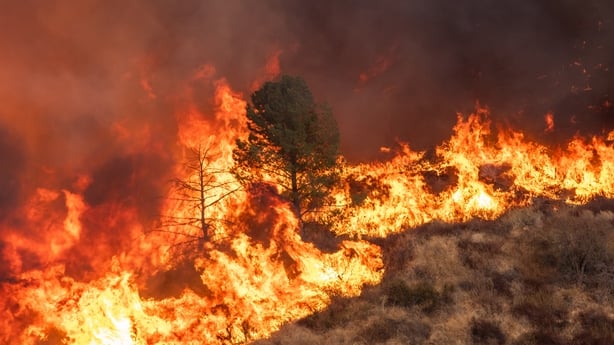A World Weather Attribution study by 32 international wildfire scientists has confirmed that human-caused climate change worsened the ferocious wildfires that devastated parts of Los Angeles in recent weeks.
The rapid analysis found that climate change significantly contributed to reduced rainfall and dried out vegetation, as well as an increasing overlap between seasonal flammable drought conditions and strong Santa Ana winds which drove the fires.
The group of scientists that conducted this analysis has studied the influence of climate change on more than 90 extreme events around the world in recent years.
We need your consent to load this rte-player contentWe use rte-player to manage extra content that can set cookies on your device and collect data about your activity. Please review their details and accept them to load the content.Manage Preferences
In this case they found global warming from burning fossil fuels made the hot, dry and windy conditions that drove the LA fires and made them 35% more likely to occur than in pre-industrial times.
They also warned that the fire-prone conditions will become a further 35% more likely if warming reaches 2.6C, the minimum currently expected by 2100.
They show also that low rainfall in the LA area from October to December is now about 2.4 times more likely to occur, and fire-prone conditions are typically in place for 23 extra days each year.

The scientists warned too that water infrastructure in the LA region is not designed to fight a rapidly expanding wildfire.
It was unable to keep up with the scale and extreme needs of the Eaton and Palisades wildfires which broke out on 7 January.
They were fanned by warm hurricane force Santa Ana Mountain winds, burning through tinder-dry vegetation and spreading rapidly into urban areas.
"All the pieces were in place for a wildfire disaster..."
At least 28 people are known to have died, more than 16,000 structures have been destroyed, and millions have been affected by toxic smoke.
Dry vegetation leads to deadly infernos
World Weather Attribution Researcher at the Centre for Environmental Policy, Imperial College London, Dr Clair Barnes, said: "Usually by this time of year, there has been enough rainfall to dampen vegetation and so dampens the fire risk before the Santa Ana winds arrive.
"But this winter, until this weekend at least, there's been very little rain, making the vegetation very dry and flammable. This is compounded by two previous winters in which there was above average rainfall. That caused more plant growth and left more vegetation to dry out and to add fuel."
She added: "Drought conditions are more frequently pushing into winter, increasing the chance a fire will break out during strong Santa Ana winds capable of turning small ignitions into deadly infernos."
October-December rainfall in Southern California has historically brought an end to the wildfire season. But in recent decades, these rains have decreased.

An analysis of historical weather data in today’s report finds low rainfall across those three months is about 2.4 times more likely in neutral El Niño conditions, and a further 1.8 times more likely in warm La Niña conditions compared to the preindustrial climate.
It says hotter air temperatures are also evaporating more moisture from plants, making them easier to burn.
Drier, flammable conditions persisting later in the year increase the chance the Santa Ana winds will cause wildfires in December and January, the scientists say.
The study was conducted by 32 researchers as part of the World Weather Attribution group, including scientists from universities and meteorological agencies in Brazil, Portugal, the US, Sweden, the Netherlands, France and the United Kingdom.
Professor of Geography at the University of California, Park Williams, said: "All the pieces were in place for a wildfire disaster - low rainfall, a build-up of tinder-dry vegetation, and strong winds.
"However, the real reason they become disasters is that homes have been built in areas where fast-moving, high-intensity fires are inevitable.
"Communities can’t build back the same because it will only be a matter of years before these burned areas are vegetated again and a high potential for fast-moving fire returns to these landscapes."








